The ADATA Premier SP550 SSD Review: A Second Look At Silicon Motion's SM2256 Controller
by Billy Tallis on March 23, 2016 8:30 AM ESTMixed Random Read/Write Performance
The mixed random I/O benchmark starts with a pure read test and gradually increases the proprotion of writes, finishing with pure writes. The queue depth is 3 for the entire test and each subtest lasts for 3 minutes, for a total test duration of 18 minutes. As with the pure random write test, this test is restricted to a 16GB span of the drive, which is empty save for the 16GB test file.
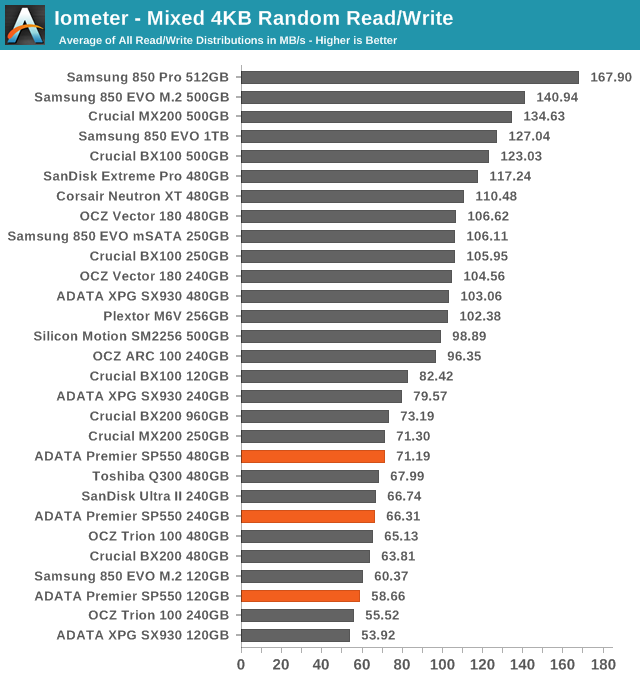
Despite its poor random write speed, the SP550 keeps pace overall with its low-end competition on the mixed random I/O test.
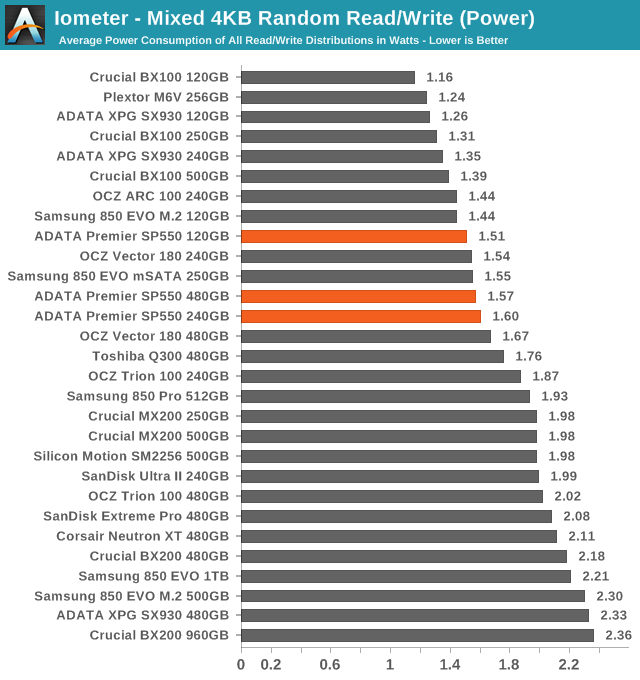
The SP550's power consumption is good but not great, so its efficiency ends up better than competitors like the OCZ Trion 100 and the SanDisk Ultra II, but the high-end drives are delivering performance that more than justifies their higher power consumption.
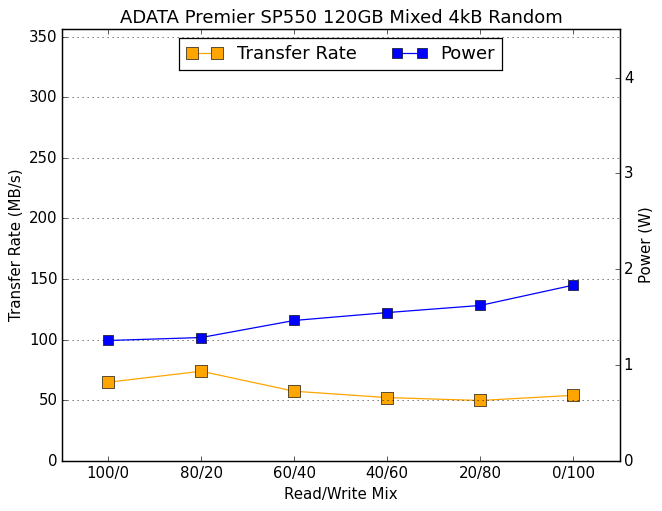 |
|||||||||
The drives that score best on the mixed random I/O test benefit from a big spike in performance in the write-heavy final stages, but the SP550 doesn't have that peak. Its performance variation across this test is relatively small, and the power consumption only grows modestly as the workload becomes more write-heavy.
Mixed Sequential Read/Write Performance
The mixed sequential access test covers the entire span of the drive and uses a queue depth of one. It starts with a pure read test and gradually increases the proprotion of writes, finishing with pure writes. Each subtest lasts for 3 minutes, for a total test duration of 18 minutes. The drive is filled before the test starts.
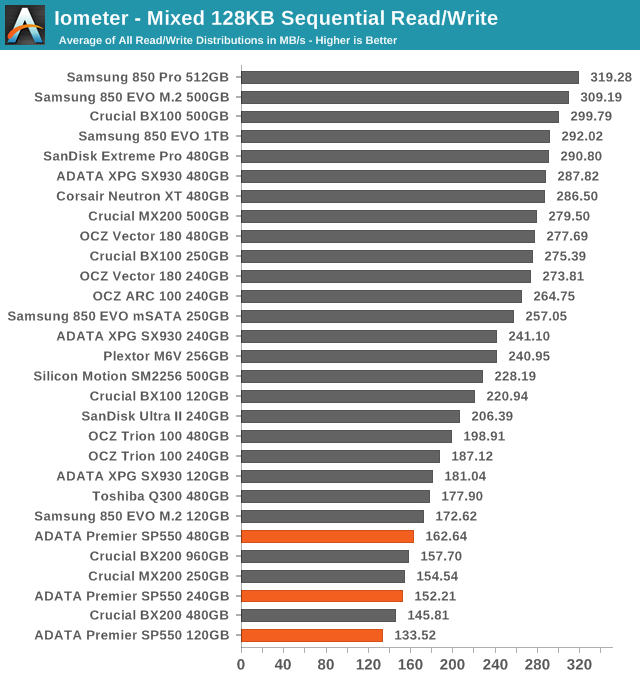
Unlike the mixed random test, the SP550's poor write speeds really hurt it relative to the competition on the mixed sequential test and keep it near the bottom of the chart.
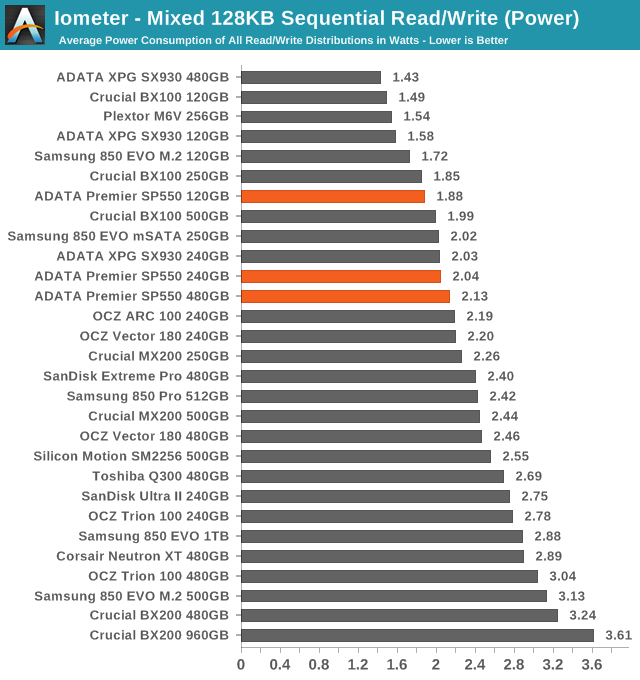
The SP550's power consumption isn't out of control like the Crucial BX200's, but its efficiency is still poor.
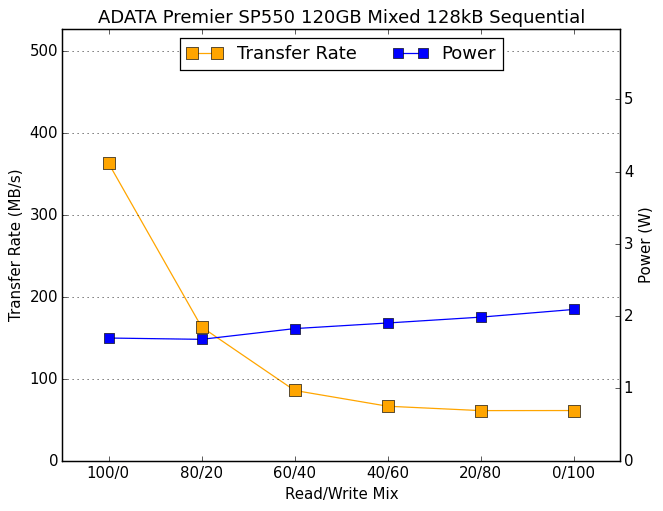 |
|||||||||
Top performers on the mixed sequential test show a U-shaped performance curve and the winner is often determined by which drives suffer least during the middle stages of this test. The SP550 starts out great in the pure-read phase of the test, but it's all downhill from there.










25 Comments
View All Comments
tipoo - Wednesday, March 23, 2016 - link
I never really thought about core counts in storage controllers before this review. What would your average mid range and high end SSDs have for controller CPUs?I think I also remember looking into this model for a cheap old laptop upgrade, but some reviews mentioned it didn't have a DRAM cache which made performance consistency very not consistent. That looks similar here in the charts, is this the one with no DRAM?
vladx - Wednesday, March 23, 2016 - link
Most SSD controllers use dual or tri-core ARM Cortex-R4 configurations.MrCommunistGen - Wednesday, March 23, 2016 - link
The 2TB 850Pro/EVO article here on Anandtech has a table showing core counts and clock speeds of the recent Samsung SSD controllers: MDX, MEX, MGX, MHX, all of which are 3-core ARM Cortex R4 except for the MGX which is a dual core ARM Cortex R4.The breakdown is a bit complex but it looks like MDX is 840/840 Pro. MEX is 840 EVO, 128-1TB 850 Pro, and 1TB 850 EVO. MGX is 120-500GB 850 EVO, and MHX is in the 2TB 850 Pro/EVO.
Going through historical articles (840 Pro review) I found that the Samsung 830's controller was called the MCX and it is implied but not directly stated that it was a 3-core ARM9 design.
Not to toot my own horn, but the "Update" in the 840 Pro article regarding MDX being R4 rather than ARM9 was at least partially due to an email chain I had with Anand. Yes, I emailed him instead of blasting him in the comments section. As I recall, he said the original press kit had said ARM9. I'd seen Cortex-R4 elsewhere on the 'net, and Anand reached out to Samsung for confirmation. I assume he got it because he updated the article later that day.
I don't remember seeing much info on core counts for other controllers, but the 840 Pro article also has a table where it notes DRAM Size for various controllers of the time. What's notable to me is that the old Intel controllers like in the X25M G2 didn't cache user data, only the mapping tables, so the G3 is listed in the table as using up to 64MB cache.
Also notable is that the SandForce controllers didn't use a DRAM cache - probably a large part of their huge industry success, in addition to their (at the time) class leading performance, and the fact that they sold turn-key solutions to OEMs.
Billy Tallis - Wednesday, March 23, 2016 - link
The SP550 uses Samsung DRAM. Silicon Motion does have a controller designed for DRAM-less MLC drives, but their controllers for TLC SSDs all still have a DRAM controller. I've been told that it's theoretically possible to use SM2256 or SM2258 without external DRAM, but I don't know if anyone has actually written the firmware necessary to accomplish that. The performance hit of operating without external DRAM is so far something that is usually only acceptable for USB drives, not mass-market SATA SSDs.hojnikb - Wednesday, March 23, 2016 - link
Well, sandforce and sm246xt perform just fine without dramghanz - Wednesday, March 23, 2016 - link
In general, they perform fine for light & general user scenarios, but IOPS suffers.In SM2246XT product brief, random reads are quoted at 28,000 IOPS & random Write at 65,000 IOPS (120GB SSD with Toshiba 19nm MLC).
Both Sandforce & SM2246XT are only used with MLC NAND since they were not design to work with TLC ones.
The IOPS drop on a theoretical SSD controller without external dram & working with TLC NAND will be much worse I presume.
Samus - Wednesday, March 30, 2016 - link
Any TLC platform without DRAM or an SLC caching mechanism is going to burn out the NAND; the wear leveling will be off the wall.Pizzahut23 - Wednesday, March 23, 2016 - link
Are we going to get a review of the phison PNY cs2211? It was recommend last month on the recommend budget SSD list. How does it compare to the legendary bx100 which is about the same price? Is it the new go to budget SSD?Billy Tallis - Wednesday, March 23, 2016 - link
I've tested both the PNY CS1311 and CS2211. They won't be the next review I post, but probably the one after that. As compared to the BX100, the CS2211 is very broadly in the same performance class, but its different controller architecture means it has very different strengths and weaknesses.ghanz - Wednesday, March 23, 2016 - link
Hi Billy, are there any plans to review the Sandisk Plus 240gb or/& 480gb?It's probably cheapest MLC drive in lower capacities now I believe.
While it's similar to the Sandisk extreme 500, it will be interesting to see the differences of the same SM2246XT controller on a SATA3 interface instead of USB 3.0/3.1.
It will also be interesting to compare a budget MLC drive with the influx of recent budget TLC drives.